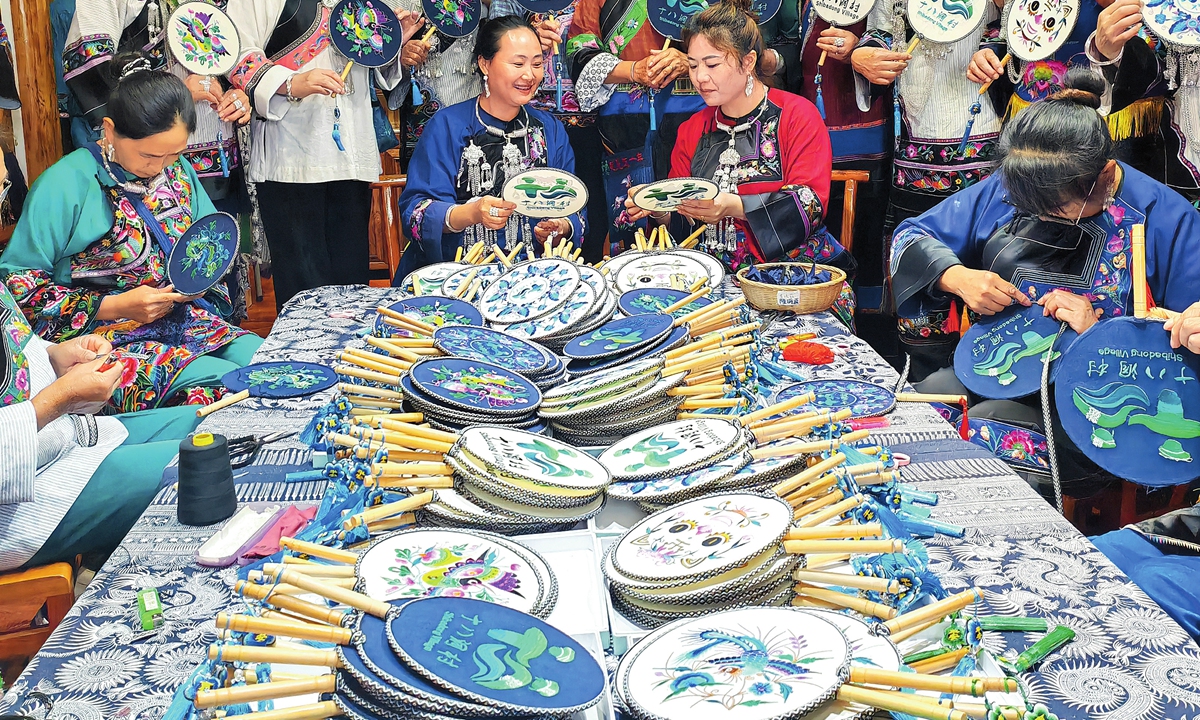Targeted poverty relief leads village to prosperity


China’s Rural Revitalization: A Model for Sustainable Development
Introduction
Nestled in the remote mountains of Central China’s Hunan Province, Shibadong is a picturesque village mainly populated by people of the Miao ethnic group. Residents of this village have long embraced a modest way of life, gathering wild vegetables and savoring smoked bacon, while reveling in their distinctive songs and dances within their isolated community. The expansive mountains not only sustain their basic needs, but also bar the advancements of modern society.

Residents from Shibadong village show traditional embroidery works. Photo: Courtesy of China Rural Revitalization magazine
Tailored Solutions for Sustainable Development
On November 3, 2013, Chinese President Xi Jinping visited Shibadong, and introduced the concept of targeted poverty alleviation for the first time. This proposal involved implementing specific relief measures based on the unique conditions of each local area.
“When we are reducing poverty, we should avoid chanting slogans and setting overambitious goals. The key to poverty alleviation is to be realistic, to adjust measures to local conditions, to give guidance based on specific situations and to take targeted measures,” Xi said.
The initial task was to confirm which groups require assistance. In late 2013, a team was sent to Shibadong to determine which households were in need, with government officials assigned to oversee the implementation of specific measures.
Various strategies for poverty reduction were employed, including developing sustainable small businesses in different industries, enhancing local infrastructure and rural surroundings, providing financial support, and bolstering social security.
Taking into account its unique circumstances, the village decided to focus on several key industries: rural tourism, embroidery, agriculture, animal husbandry, and bottled water production.
Through a series of targeted measures, Shibadong has made significant changes. All households in the village are now connected to tap water, the power grid, and mobile network. In terms of other infrastructure, a total of 225 houses in the villages were transformed with aspects of their Miao characteristics kept in place. A wastewater treatment plant and two garbage sorting centers were built and initiated, while the local primary school and clinic were also upgraded.
With the poverty alleviation efforts represented by Shibadong, a total of 208,000 impoverished villages nationwide have emerged from living with only just enough. At the same time, challenges including transportation, power and water supply, education, and healthcare have largely been addressed.

A kiwi planting base in the Shibadong village, Central China’s Hunan Province Photo: Courtesy of China Rural Revitalization magazine
Attracting Talent and Sharing Success
A growing number of young people who used to work outside Shibadong are returning to their hometown and starting their own businesses, while university graduates from the village are also choosing to return and contribute to the development of the village.
Over the past 10 years, nearly 100 villagers from Shibadong have returned to their hometown, dedicating themselves to the poverty alleviation and rural revitalization efforts in the village. The return of talent has injected new momentum into the development of industries in the village.
From rural tourism and kiwi planting to bottling water and traditional embroidery, multiple industries unique to the village have largely activated its internal economy, lifting local incomes.
Global Recognition and Sustainable Development Goals
The resolution of eradicating rural poverty was approved during the 73rd session of the General Assembly of the United Nations in 2018, representing the successful model of Shibadong has been introduced to the world.
The village’s development has opened a window for the world to understand China’s poverty alleviation experience. People from all over the world come in groups to explore this Miao village, experience the practice of China’s poverty alleviation, and search for the secret to achieving rural revitalization and happiness.
In May 2022, a delegation formed with 120 young officers from African countries including Tanzania, South Africa, Namibia, and Zimbabwe, among others, held an in-depth exchange with Shibadong villagers via video link.
Looking ahead, Shibadong will not slow the pace of progress, continuously drawing strength from the fruitful results of targeted poverty alleviation. As a pioneer in targeted poverty alleviation, it continues to set an inspiring example and shares the secret of happiness in harmonious rural areas with the world.
In February 2021, Xi announced that absolute poverty has been eradicated in the world’s most populous country, home to over 1.4 billion people. He emphasized that efforts must be made to prevent any large-scale relapse into poverty and pledged that China will attach greater importance to the pursuit of common prosperity.
SDGs, Targets, and Indicators
-
SDG 1: No Poverty
- Target 1.1: By 2030, eradicate extreme poverty for all people everywhere, currently measured as people living on less than $1.25 a day.
- Target 1.4: By 2030, ensure that all men and women, in particular, the poor and the vulnerable, have equal rights to economic resources, as well as access to basic services, ownership, and control over land and other forms of property, inheritance, natural resources, appropriate new technology, and financial services, including microfinance.
-
SDG 8: Decent Work and Economic Growth
- Target 8.3: Promote development-oriented policies that support productive activities, decent job creation, entrepreneurship, creativity, and innovation, and encourage the formalization and growth of micro-, small-, and medium-sized enterprises, including through access to financial services.
- Target 8.6: By 2020, substantially reduce the proportion of youth not in employment, education, or training.
-
SDG 9: Industry, Innovation, and Infrastructure
- Target 9.1: Develop quality, reliable, sustainable, and resilient infrastructure, including regional and transborder infrastructure, to support economic development and human well-being, with a focus on affordable and equitable access for all.
- Target 9.3: Increase the access of small-scale industrial and other enterprises, in particular in developing countries, to financial services, including affordable credit, and their integration into value chains and markets.
-
SDG 11: Sustainable Cities and Communities
- Target 11.1: By 2030, ensure access for all to adequate, safe, and affordable housing and basic services and upgrade slums.
- Target 11.3: By 2030, enhance inclusive and sustainable urbanization and capacity for participatory, integrated, and sustainable human settlement planning and management in all countries.
-
SDG 17: Partnerships for the Goals
- Target 17.9: Enhance international support for implementing effective and targeted capacity-building in developing countries to support national plans to implement all the Sustainable Development Goals, including through North-South, South-South, and triangular cooperation.
- Target 17.18: By 2020, enhance capacity-building support to developing countries, including for least developed countries and small island developing States, to increase significantly the availability of high-quality, timely, and reliable data disaggregated by income, gender, age, race, ethnicity, migratory status, disability, geographic location, and other characteristics relevant in national contexts.
Table: SDGs, Targets, and Indicators
| SDGs | Targets | Indicators |
|---|---|---|
| SDG 1: No Poverty | Target 1.1: By 2030, eradicate extreme poverty for all people everywhere, currently measured as people living on less than $1.25 a day. | No specific indicators mentioned in the article. |
| SDG 1: No Poverty | Target 1.4: By 2030, ensure that all men and women, in particular, the poor and the vulnerable, have equal rights to economic resources, as well as access to basic services, ownership, and control over land and other forms of property, inheritance, natural resources, appropriate new technology, and financial services, including microfinance. | No specific indicators mentioned in the article. |
| SDG 8: Decent Work and Economic Growth | Target 8.3: Promote development-oriented policies that support productive activities, decent job creation, entrepreneurship, creativity, and innovation, and encourage the formalization and growth of micro-, small-, and medium-sized enterprises, including through access to financial services. | No specific indicators mentioned in the article. |
| SDG 8: Decent Work and Economic Growth | Target 8.6: By 2020, substantially reduce the proportion of youth not in employment, education, or training. | No specific indicators mentioned in the article. |
| SDG 9: Industry, Innovation, and Infrastructure | Target 9.1: Develop quality, reliable, sustainable, and resilient infrastructure, including regional and transborder infrastructure, to support economic development and human well-being, with a focus on affordable and equitable access for all. | No specific indicators mentioned in the article. |
| SDG 9: Industry, Innovation, and Infrastructure | Target 9.3: Increase the access of small-scale industrial and other enterprises, in particular in developing countries, to financial services, including affordable credit, and their integration into value chains and markets. | No specific indicators mentioned in the article. |
| SDG 11: Sustainable Cities and Communities | Target 11.1: By 2030, ensure access for all to adequate, safe, and affordable housing and basic services and upgrade slums. | No specific indicators mentioned in the article. |
| SDG 11: Sustainable Cities and Communities | Target 11.3: By 2030, enhance inclusive and sustainable urbanization and capacity for participatory, integrated, and sustainable human settlement planning and management in all countries. | No specific indicators mentioned in the article. |
| SDG 17: Partnerships for the Goals | Target 17.9: Enhance international support for implementing effective and targeted capacity-building in developing countries to support national plans to implement all the Sustainable Development Goals, including through North-South, South-South, and triangular cooperation. | No specific indicators mentioned in the article. |
| SDG 17: Partnerships for the Goals | Target 17.18: By 2020, enhance capacity-building support to developing countries, including for least developed countries and small island developing States, to increase significantly the availability of high-quality, timely, and reliable data disaggregated by income, gender, age, race, ethnicity, migratory status, disability, geographic location, and other characteristics relevant in national contexts. | No specific indicators mentioned in the article. |
Source: globaltimes.cn








